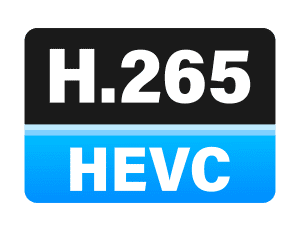Unmanned systems like drones and remote surveillance platforms require efficient video compression. As video quality improves, managing large volumes of data presents more and more of a challenge. This is where High-Efficiency Video Coding (HEVC), also known as H.265, becomes essential. Its ability to compress high-quality video while using less bandwidth makes it a game-changer for manufacturers of unmanned systems. In this post, Maris-Tech, a leading edge computing vendor, explores the benefits of HEVC, how it compares to its predecessor AVC (H.264), and how to choose the best HEVC encoder for your unmanned system needs.
What is an HEVC Encoder/Decoder?
An HEVC hardware encoder compresses video files into smaller sizes without losing the high-quality resolution required in real-time operations, such as surveillance and reconnaissance missions. At the same time, the HEVC video decoder decompresses the video for viewing. H.265’s advanced compression techniques make it ideal for data-intensive applications where bandwidth is limited but high-quality video transmission is necessary.
AVC/H.264 vs. HEVC/H.265
AVC (H.264) has long been the standard for video compression, offering good quality at reasonable file sizes. However, as technology evolves, the newer version of the encoder, HEVC/H.265, is becoming the preferred choice due to its enhanced efficiency in several key areas.
Reduced Bandwidth Requirements for HEVC Encoders
HEVC (H.265) reduces bitrate by 50% compared to H.264, allowing users to achieve the same video quality while using half the bandwidth. This reduction is particularly beneficial for unmanned systems, which often operate over constrained communication links. With HEVC’s advanced compression methods, it becomes easier to transmit high-definition video in real-time, even in environments with limited network infrastructure.
In addition, HEVC is optimized for 4K encoding and higher video resolutions, which are crucial for unmanned systems that rely on high-definition video for detailed reconnaissance and monitoring. By using HEVC hardware encoding, these systems can maintain superior video quality while efficiently managing bandwidth.
Enhanced Streaming Capabilities
Latency is another area where HEVC outperforms H.264. The reduced latency delivered by HEVC hardware decoder/encoder is key for real-time operations in drones and other unmanned platforms. In mission-critical scenarios, where every second counts, HEVC ensures that video feeds are transmitted with minimal delay, enabling real-time decision-making and navigation.
Beyond reducing bandwidth and latency, HEVC enhances streaming capabilities, allowing for low-latency, high-quality video streaming over long distances. This is critical for unmanned systems that depend on real-time video for navigation, monitoring, and data gathering. In challenging network conditions, HEVC’s efficient encoding ensures that real-time transmission is maintained without compromising video clarity.
Benefits of Using an HEVC Hardware Encoder
While software encoding solutions are available, HEVC hardware encoders offer significant advantages for unmanned systems:
- Faster processing: Dedicated hardware accelerates video encoding, reducing latency and improving real-time performance.
- Energy efficiency: HEVC hardware encoders are more energy-efficient than software-based solutions, making them a good choice for battery-powered systems like drones.
- Reliability in harsh environments: Unmanned systems often operate in extreme conditions. Hardware encoders are more robust and reliable than software alternatives, ensuring consistent performance.
Use Cases for HEVC Encoders in Unmanned Systems
HEVC encoders play an important role across various applications within unmanned systems, offering significant improvements in video quality, bandwidth efficiency, and real-time transmission. Here are some key use cases where HEVC encoding plays a role in driving performance and operational success:
Drone-Based Surveillance and Reconnaissance
UAVs, or drones, are increasingly used for surveillance and reconnaissance in both military and civilian sectors. Equipped with HEVC encoders, these drones can capture and transmit high-resolution video over long distances, enabling operators to receive critical intelligence in real-time. HEVC’s ability to maintain high-quality video while reducing bandwidth allows operators to rely on clear, continuous video feeds even in areas with limited network infrastructure. This is especially important in applications like border security, disaster relief, and battlefield reconnaissance, where timely and reliable information is critical to success.
Remote Industrial Monitoring and Inspection
In industries like oil and gas, power generation, and infrastructure, unmanned systems equipped with HEVC encoders monitor and inspect remote or hazardous environments. High-definition video transmitted via HEVC allows operators to assess equipment conditions and identify potential failures without the need for human presence in dangerous areas. By minimizing bandwidth usage, HEVC enables lengthy monitoring sessions and facilitates video transmission over low-bandwidth satellite links — making it ideal for offshore platforms, remote pipelines, and industrial facilities.
Search and Rescue Operations
In search and rescue missions, time is of the essence. Drones equipped with HEVC encoders can stream real-time, high-definition video to ground teams, helping them locate victims more quickly and navigate challenging environments such as mountainous terrain or dense forests. The low-latency nature of HEVC ensures that rescue teams receive up-to-the-minute visual data, improving response times. In addition, HEVC’s compression efficiency allows drones to cover wider areas without compromising video quality, making them a vital tool in large-scale rescue efforts.
Unmanned Ground Vehicles (UGVs) for Defense and Security
UGVs are employed for a range of defense and security tasks, including explosive ordnance disposal (EOD), perimeter security, and urban reconnaissance. UGVs equipped with HEVC encoders can transmit real-time video feeds from the field back to command centers, providing operators with a clear view of the operational environment. This allows for rapid decision-making in high-stakes situations. The bandwidth efficiency of HEVC is especially valuable when UGVs are operating in urban environments where network infrastructure may be degraded or compromised.
Maritime Surveillance and Monitoring
HEVC encoders are also used in unmanned maritime systems for coastal surveillance, environmental monitoring, and naval defense. In these applications – where vessels must transmit video over massive distances – HEVC’s superior compression ensures that video quality remains intact while bandwidth usage is minimized. This is critical for detecting and tracking vessels, monitoring illegal activities such as piracy or smuggling, and conducting environmental assessments in real-time.
Agriculture and Environmental Monitoring
Unmanned systems equipped with HEVC encoders are increasingly used in agriculture for crop monitoring, irrigation management, and environmental assessments. Drones can capture high-resolution images and video, which can then provide farmers with detailed insights into crop health, soil conditions, and water usage. HEVC’s efficient video compression allows for the collection and transmission of large volumes of data, even in rural areas with limited connectivity.
Intelligence, Surveillance, and Reconnaissance Missions
In military applications, HEVC encoders are indispensable for Intelligence, Surveillance, and Reconnaissance (ISR) missions. UAVs and other unmanned systems equipped with HEVC can stream high-definition video to command centers, allowing military personnel to track enemy movements, gather actionable intelligence, and monitor areas of interest with better accuracy. HEVC’s reduced bandwidth requirements make it ideal for transmitting video in environments where communication channels may be limited or at risk of interference.
Choosing the Right HEVC Video Encoder
When selecting an HEVC video encoder for your unmanned system, consider these factors:
- Latency: Low latency video streaming is crucial for real-time applications. Look for encoders that minimize delay, especially if your unmanned system relies on live video feeds.
- Bandwidth efficiency: Does the encoder provide the best video quality while using the least amount of bandwidth? This is necessary to ensure smooth operation even in low-bandwidth environments.
- Durability and power consumption: Unmanned systems often operate in harsh environments. Ensure the encoder can withstand extreme conditions and is energy-efficient for long periods of time.
- Scalability: Consider an encoder that supports 4K or even 8K resolutions, future-proofing your unmanned system as video quality demands increase.
Maris-Tech’s Jupiter Family: High-Definition, Low-Latency HEVC Encoder for Unmanned Systems
Maris-Tech’s family of Jupiter H.264/5 low-latency encoder/decoder platforms are designed to handle multiple video channels, delivering real-time intelligence gathering and analytics-based situational awareness capabilities. Jupiter offers a perfect balance of video quality, bandwidth efficiency, and low power consumption. Designed specifically for unmanned systems, these platforms enable real-time, high-definition video transmission, even in the most challenging environments.
The system capabilities of the HEVC encoder include video and audio capture, encoding, decoding, transcoding and display, forward error correction (FEC), raw data pre-processing, and low latency streaming over Ethernet. The solution supports multiple channel analog SD/HD video and audio H.264 and H.265 encoding, streaming and recording, dual channel analog SD/HD H.264/5 decoding and playback. Jupiter Nano features web-browser-based control and API-based control over networks and serial communication.
For more information about Jupiter and Maris-Tech’s products, contact Maris-Tech.



